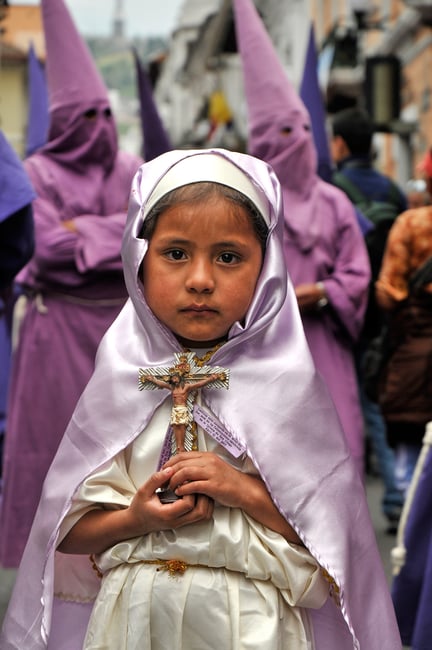The celebration of the resurrection of Jesus Christ is very different in various parts of the world. In the Philippines, some religious people reenact the crucifixion, nails and all. On the Greek island of Corfu, they throw large clay pots and jugs of water out the windows. In this photo essay, I’ll take you to Quito, Ecuador, to watch an unusual Easter procession.
When the Spanish conquistadors invaded what is now Peru and Ecuador in the first half of the 16th century, it was a disaster for the indigenous people. Their first encounter with Christianity and the mercy of Jesus Christ was not a happy one. The Spanish conquerors destroyed the Incan Empire with the hooves of their horses. New Spanish cities, such as the Ecuadorian capital of Quito, were built on the ruins of former Inca settlements.

You would think that the suffering and blood spilled would make the indigenous population implacably resistant to anything European, including religions. But you’d be wrong. In the centuries following the massacres and enslavement of the native Indians, Christianity also had many opportunities to improve its image in South America.

Relatively recently, in the 1960s, Catholic bishops took it upon themselves to aid in social change. They distributed land to poor Indians and also worked to increase literacy.
However, I cannot say that Christianity is just the faith of the poor in Ecuador. Not at all. In fact, 94% of the population here today belongs to the Roman Catholic Church, so it truly is the religion of the masses.

The tradition of the “Jesús del Gran Poder” procession in the center of Quito also began in the early 1960s. Each year, more than 200,000 pilgrims gather in the city on Easter Sunday to celebrate the resurrection of Christ.
Many in the crowded procession are dressed in costumes that – to put it bluntly – strongly resemble a purple version of the Ku Klux Klan. It’s a jarring sight at first. However, the beliefs and purpose behind the procession could not be more different. Underneath the sinister-looking hoods are “cucuruchos” representing sinners and martyrs. They walk the streets barefoot with chains on their feet to atone for their sins.

Other prominent figures in the procession are “Verónicas.” These women in purple tunics with veiled faces pay homage to the woman who wiped Jesus’s face with her veil. Others, following Christ’s example, carry their cross in the procession. And believe me, it’s really heavy. It takes strong faith and strong arms to drag it along the cobblestones of the steep streets at about 3000 meters above sea level.


Elsewhere in Ecuador, the celebrations are less extravagant. In the Chimbo Valley, for example, farmers spend a week stroking their fruit trees and begging: “Don’t be lazy, give us your fruit!” I think that’s a nice tradition. I’ll have to give my apple tree some words of encouragement this year, too – maybe it would help.

For me, as a foreigner, photographing the parade was incredibly exciting. In today’s globalized world, many traditions blend into a kind of vague, soulless mixture. The Procesión Jesús del Gran Poder was different. It was refreshing in its authenticity and emotion. You could see the passion and sincerity in the faces of the participants.




If you are interested in reportage or street photography, I wish you good luck in your search for genuineness and authenticity, even at home. What seems familiar to you may be remarkable to people elsewhere in the world – so, get out and photograph, and tell me what you see.

Zdravím Libore, nádherné fotky z oslav Velikonoc v dalekém ekvádorském Quitu. Ať se daří! VH
Ahoj Václave, je hezké, tady na Photography Life vidět Češtinu. Děkuji za ni i za milý komentář. Přeju Ti hezký den a příjemné počtení dalších článků.
Superb shots, totally immersed – very impressive!
Thank you, Ashley. I’m glad you found the photos and article from Ecuadorian Easter interesting.
Thanks for this unexpected but most welcome article. I viewed a similar procession in Mexico City, with costumes, as in Quito, depicting the historical event of Crucifixion and Resurrection. I got the same feeling about the people as you did.
Thank you for your comment, Art. I would guess that many of the traditions are very similar throughout South America. It’s great that, at least in the countries I’ve visited, there’s still something to celebrate. Here in Europe (and I’d guess North America is similar), similar “fiestas” are rare. In Colombia, Ecuador, or Peru, you could always spend a weekend in some kind of parade with dancing and music.